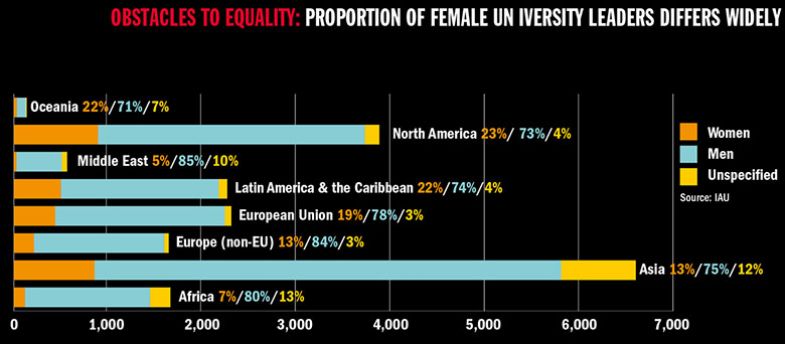The lengths to which women still have to go to break the glass ceiling in higher education are laid bare by new data which show that just one in six universities globally has a female leader.
A unique directory, the International Association of Universities’ World Higher Education Database, covers 19,142 public and private institutions in 196 countries. It reveals that, while Sweden can boast of gender parity at the top of its universities – 49 per cent of leaders are women, and 51 per cent are men – 54 nations do not have a single female vice-chancellor.
The portal also reveals wide disparities between regions. North America has the higher proportion of female university leaders – 23 per cent – compared with just 5 per cent in the Middle East.
In particular, Europe lags behind the leading anglophone sectors, with just 16 per cent of institutions led by a woman. If just the 28 member states of the European Union are counted, this figure rises to 19 per cent, but this remains well behind not only the United States (24 per cent) and Canada (21 per cent), but also Australia (25 per cent) and New Zealand (28 per cent).
In Asia, 13 per cent of universities are led by a woman.

There were also “huge differences” within regions, said Amanda Sudic, the IAU’s information officer. She highlighted a number of countries that significantly outperformed their regional average, including South Africa (28 per cent), the Philippines (32 per cent), Slovenia (38 per cent), Panama (38 per cent) and Cuba (38 per cent).
“The research confirms that worldwide the glass ceiling remains intact for women in higher education leadership,” said Ms Sudic, who carried out the research with IAU colleague Juliette Becker.
“However, it also confirms that, to some extent, opportunities for women to access the highest echelons of leadership in academia is related to where they are in the world.”
Joan Wallach Scott, one of the pioneers of gender history, said that gender inequality was “a fact in every country in the world”. Even in countries with a higher representation of women in leadership positions, there was “a persisting view that men are better leaders than women”, she said.
The emerita professor at Princeton’s Institute for Advanced Study added that she feared that it would be “a very long time” before parity was achieved globally, especially given the “rise of right-wing authoritarian parties all over the world”.
Laurie Cohen, professor of work and organisation at the University of Nottingham, agreed that the pace of change was “very slow, with some talk but little commitment to real action to address intractable problems”.
“There is still a certain complacency, and a belief that ‘time will take care of it’, which is clearly not the case,” Professor Cohen said.
While there were “plenty of highly competent women around” to fill leadership roles, the issue was “whether we think gender equality matters, and how much”.
She made the case for “explicit, mandated transparent goals, which we need to be accountable to”. But she also warned that top-down accreditation programmes were “not panaceas” because they can soon become “overly complex and unwieldy” and “people soon learn how to play the system”.
Deborah Werner, a project manager at Germany’s Centre for Higher Education, said that if “gender parity is defined as a goal” then gender quotas, transparency in recruiting procedures and a legal framework supporting such measures could be important ways of achieving parity.
Last week Eindhoven University of Technology said that its job vacancies would be open exclusively to women for the next 18 months in order to overcome the institution’s “implicit gender bias”. Men will only be able to apply if no suitable female candidates emerge within six months.
Also last week, Ireland launched its Senior Academic Leadership Initiative, which will award funding for up to 45 senior academic leadership posts over three years and is specifically aimed at attracting “outstanding female applicants”.
Gemma Irvine, head of policy and strategic planning at Ireland’s Higher Education Authority, said that universities have to “own this problem themselves but they also need the support of the wider environment to make fundamental changes”.
Separate research published last month shows that, even if women do make it to the top, where they break the glass ceiling determines whether or not they will be paid as much as their male peers.
A paper published in Organization Science showed that, while the pay gap was closing among presidents at the US’ most prestigious universities, it remained stubbornly in place elsewhere.
Register to continue
Why register?
- Registration is free and only takes a moment
- Once registered, you can read 3 articles a month
- Sign up for our newsletter
Subscribe
Or subscribe for unlimited access to:
- Unlimited access to news, views, insights & reviews
- Digital editions
- Digital access to THE’s university and college rankings analysis
Already registered or a current subscriber? Login








